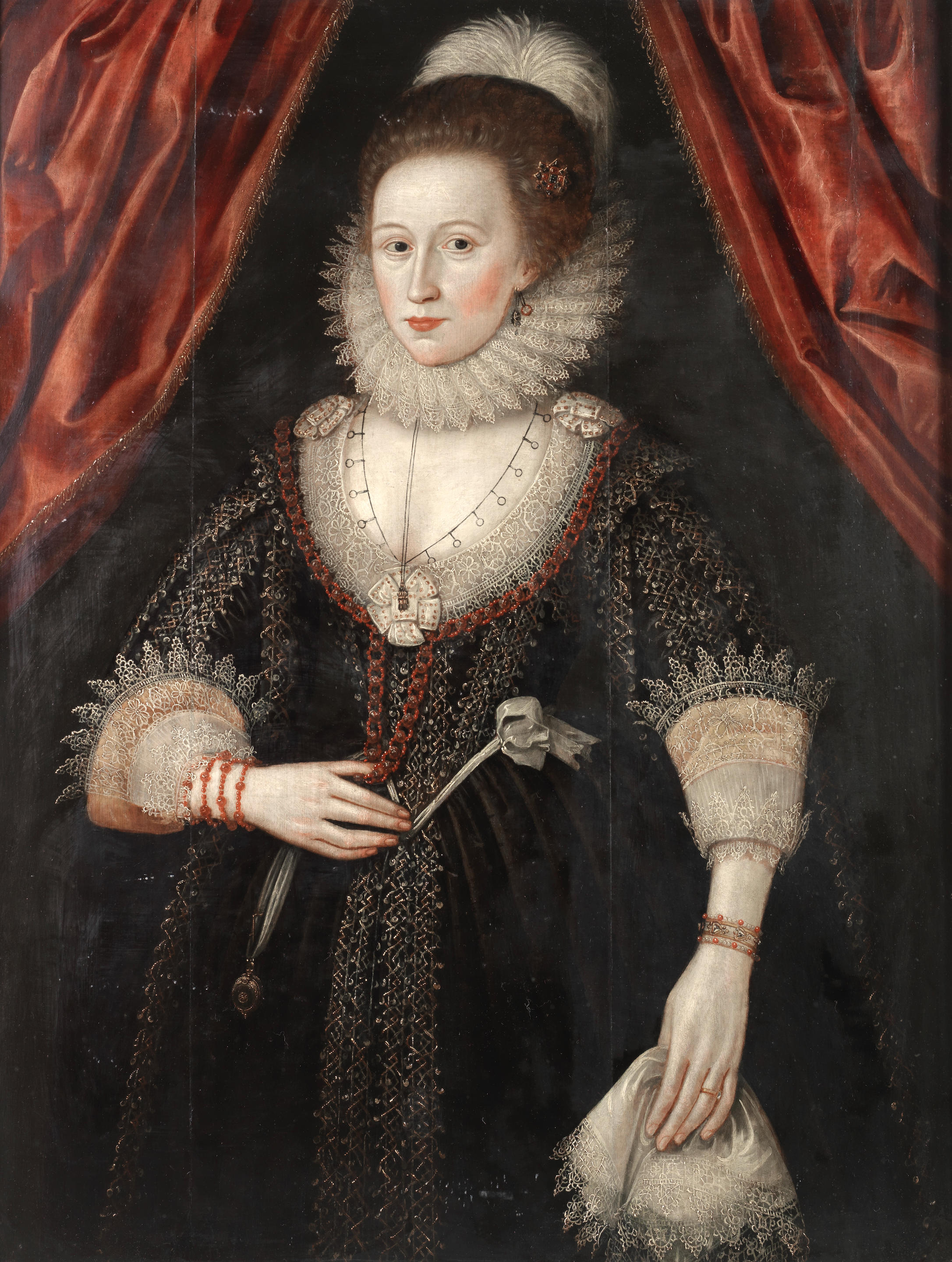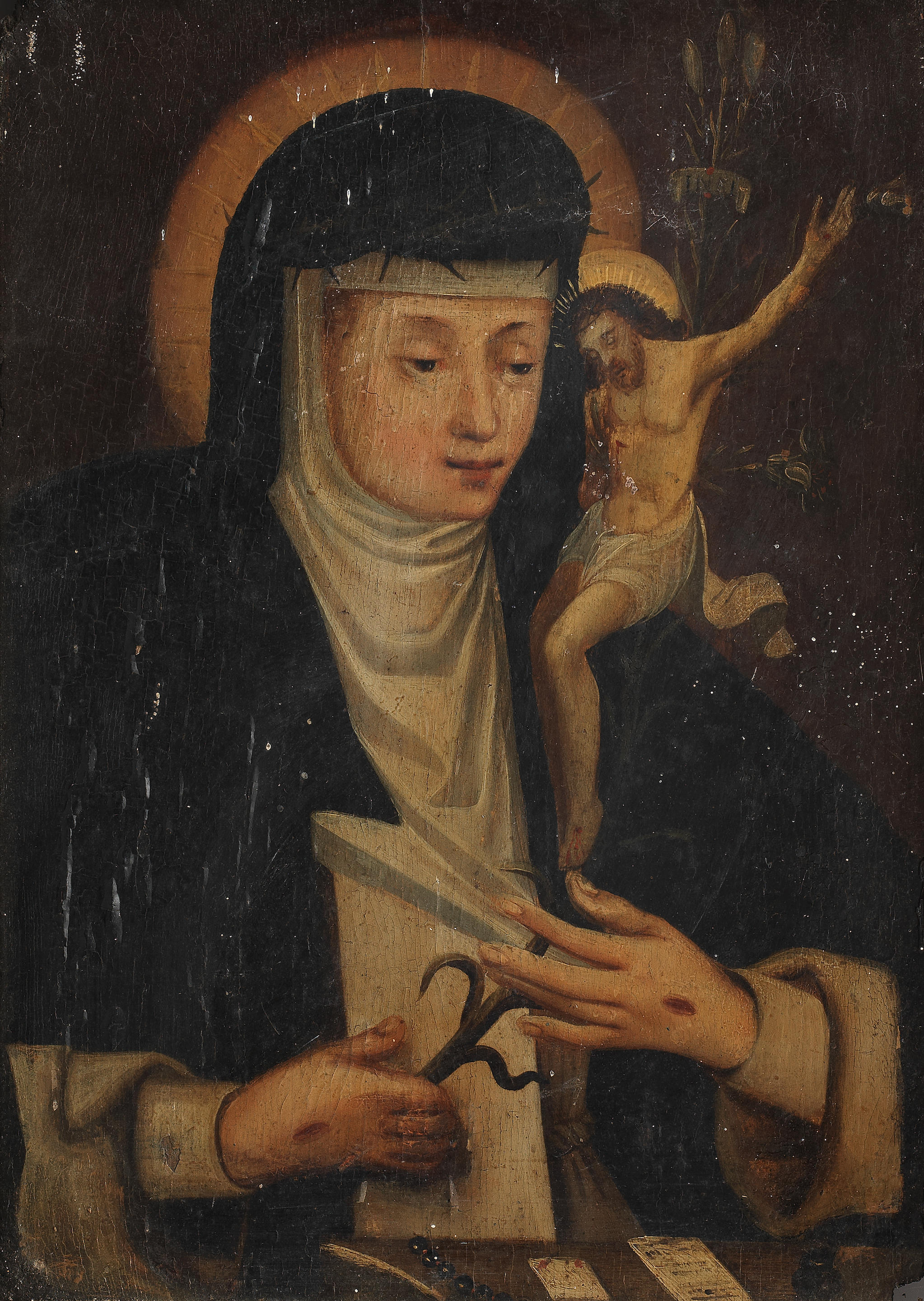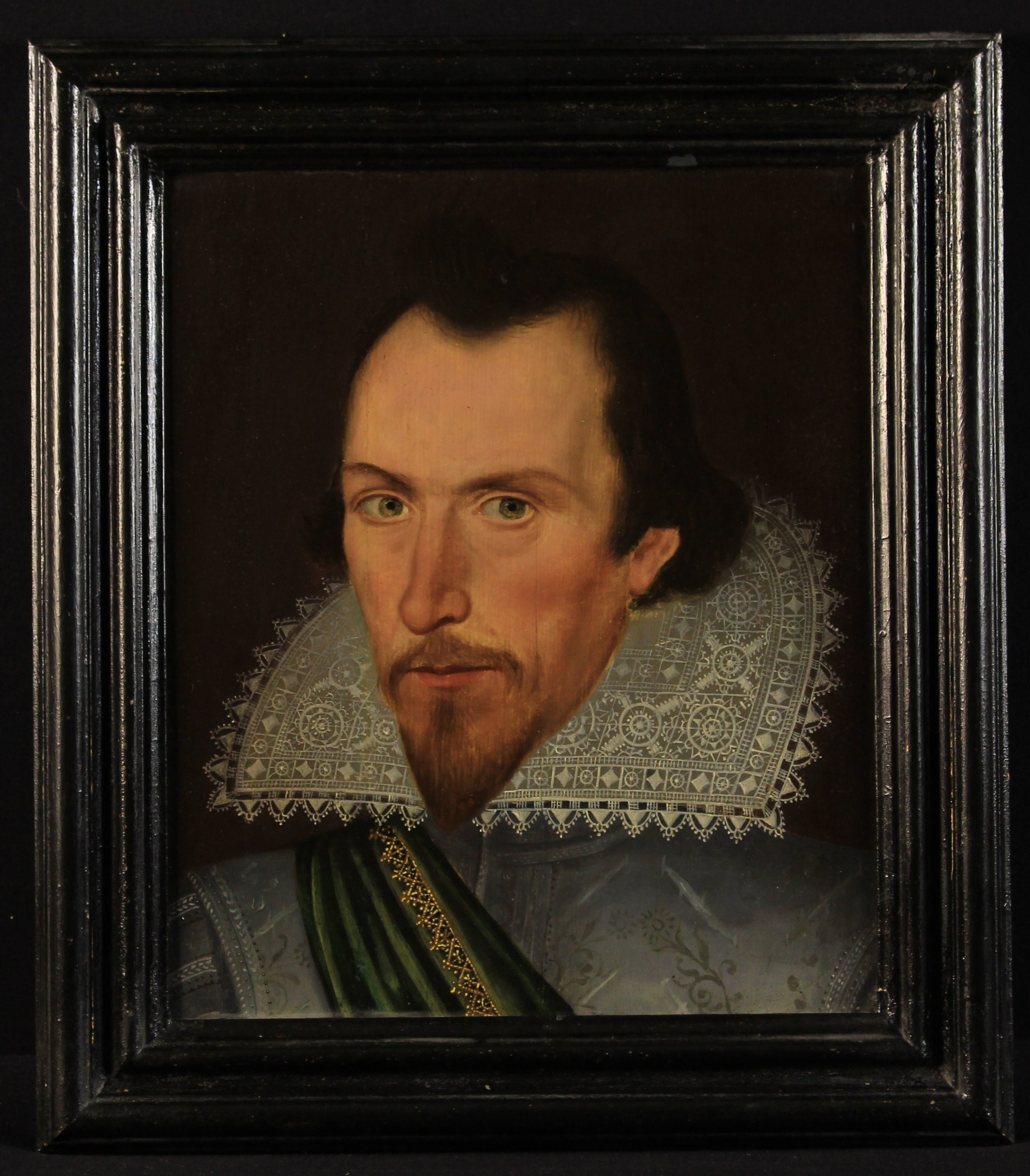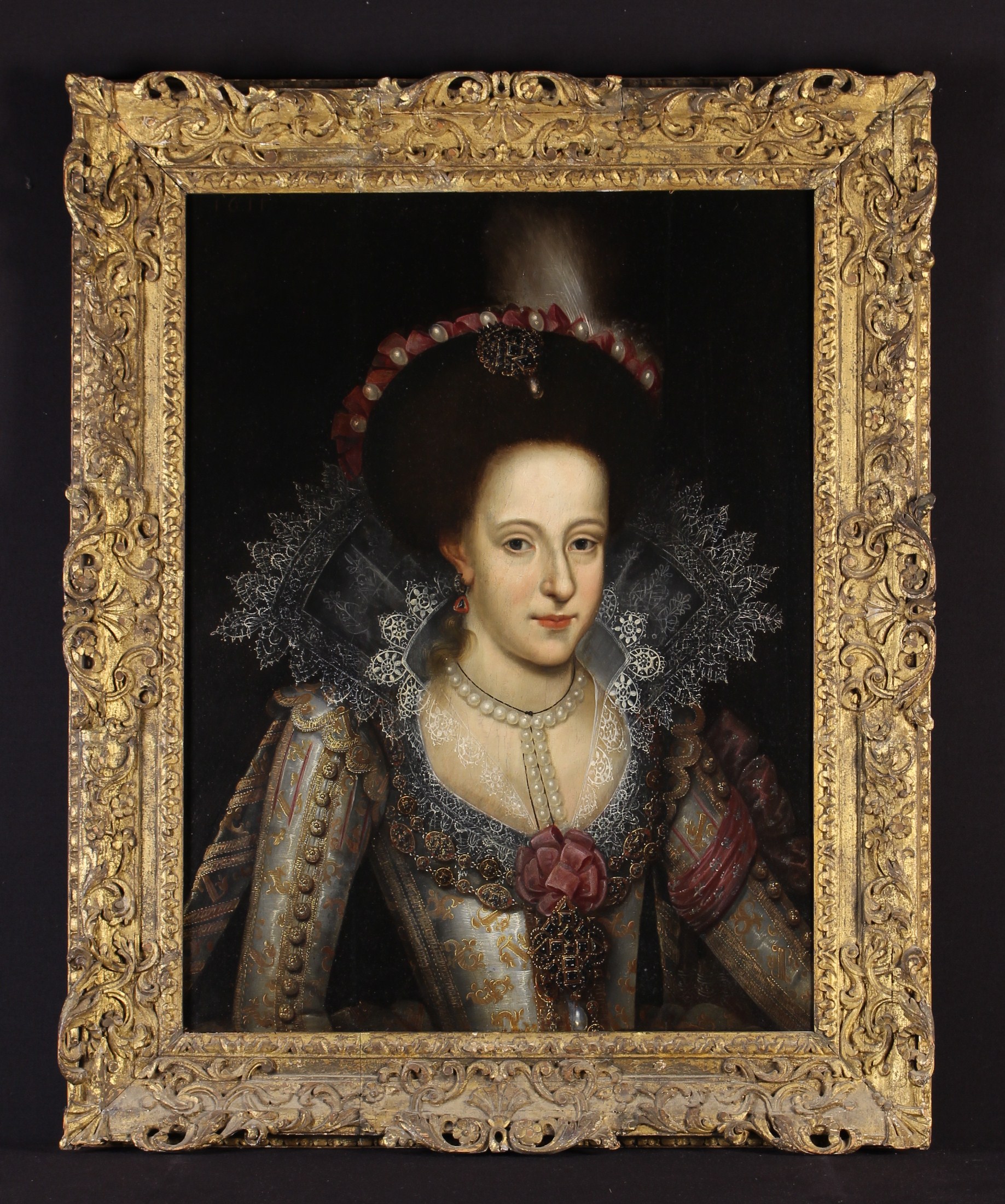CIRCLE OF WILLIAM LARKIN (c.1580-1619) PORTRAIT OF A LADY, TRADITIONALLY IDENTIFIED AS LADY ARABELLA STUART (1575-1615) Seated, three quarter length, wearing a cream dress with fine lace collar and cuffs, embroidered with pink carnations and pea pods and adorned with red rosettes, her light auburn hair dressed high with red ribbons, oil on panel Overall panel size 113 x 82cm. Provenance: Collection of Norman Lamplugh, c.1931; Sothebys London, c.1963-1965 (purchased for £400 by the consignor) Exhibited: London, Grosvenor Square, Loan Exhibition of Scottish Art and Antiquities, Feb-Mar 1931, no.1147 (illustrated, as by Paul Van Somer) * The identification of Lady Arabella Stuart as the sitter is traditional. Lady Arabella (sometimes Arbella) was the daughter of Charles Stuart Earl of Lennox, the younger brother of Lord Darnley. She stood next to her cousin James in the line of succession for the English throne following Queen Elizabeth's death in 1603 (portraits of Lady Arabella and Anne of Denmark, James's Queen, are often confused). Some supporters claimed that Lady Arabella's claim was the stronger as she was English born but James succeeded peaceably and treated his cousin with leniency by exculpating her of any involvement in plots to succeed Elizabeth. A rumour that she was to be married to William Seymour, 2nd Duke of Somerset, proved to be true upon their engagement in February 1610 but Arabella then had to swear her loyalty before the King at a meeting of the Privy Council. Her jagged descent from King Henry VII and Seymour's ancestral links to Mary Tudor strengthened the couple's claim to the throne. In contravention of this, she and Seymour wed in secret in June 1610. The King feared an insurrection: Seymour was sent to the Tower for his insubordination to the King whilst his bride was put into the care Sir Thomas Perry and then of the Bishop of Durham before trying to flee to France dressed as a man. She was seized by the King's men in the English Channel and sent to the Tower where she died of malnutrition in September 1615 after refusing all food. Lady Arabella's body was buried in Westminster Abbey, directly on top of the coffin of Mary Queen of Scots. The label on the frame ascribes the picture to Federico Zuccaro (c.1540-1609) but his 1575 portraits of Queen Elizabeth and the Earl of Leicester are Zuccaro's only undisputed works painted in England and he had returned to Italy by about 1589. No wholly undisputed portrait of Lady Arabella is known although a full length image in the North Carolina Museum of Art, c.1605, ascribed to John de Critz is generally acknowledged to depict her. There are some evident facial similarities between that portrait and this lot, which may be dated to 1605-1610.
CIRCLE OF WILLIAM LARKIN (c.1580-1619) PORTRAIT OF A LADY, TRADITIONALLY IDENTIFIED AS LADY ARABELLA STUART (1575-1615) Seated, three quarter length, wearing a cream dress with fine lace collar and cuffs, embroidered with pink carnations and pea pods and adorned with red rosettes, her light auburn hair dressed high with red ribbons, oil on panel Overall panel size 113 x 82cm. Provenance: Collection of Norman Lamplugh, c.1931; Sothebys London, c.1963-1965 (purchased for £400 by the consignor) Exhibited: London, Grosvenor Square, Loan Exhibition of Scottish Art and Antiquities, Feb-Mar 1931, no.1147 (illustrated, as by Paul Van Somer) * The identification of Lady Arabella Stuart as the sitter is traditional. Lady Arabella (sometimes Arbella) was the daughter of Charles Stuart Earl of Lennox, the younger brother of Lord Darnley. She stood next to her cousin James in the line of succession for the English throne following Queen Elizabeth's death in 1603 (portraits of Lady Arabella and Anne of Denmark, James's Queen, are often confused). Some supporters claimed that Lady Arabella's claim was the stronger as she was English born but James succeeded peaceably and treated his cousin with leniency by exculpating her of any involvement in plots to succeed Elizabeth. A rumour that she was to be married to William Seymour, 2nd Duke of Somerset, proved to be true upon their engagement in February 1610 but Arabella then had to swear her loyalty before the King at a meeting of the Privy Council. Her jagged descent from King Henry VII and Seymour's ancestral links to Mary Tudor strengthened the couple's claim to the throne. In contravention of this, she and Seymour wed in secret in June 1610. The King feared an insurrection: Seymour was sent to the Tower for his insubordination to the King whilst his bride was put into the care Sir Thomas Perry and then of the Bishop of Durham before trying to flee to France dressed as a man. She was seized by the King's men in the English Channel and sent to the Tower where she died of malnutrition in September 1615 after refusing all food. Lady Arabella's body was buried in Westminster Abbey, directly on top of the coffin of Mary Queen of Scots. The label on the frame ascribes the picture to Federico Zuccaro (c.1540-1609) but his 1575 portraits of Queen Elizabeth and the Earl of Leicester are Zuccaro's only undisputed works painted in England and he had returned to Italy by about 1589. No wholly undisputed portrait of Lady Arabella is known although a full length image in the North Carolina Museum of Art, c.1605, ascribed to John de Critz is generally acknowledged to depict her. There are some evident facial similarities between that portrait and this lot, which may be dated to 1605-1610.













Testen Sie LotSearch und seine Premium-Features 7 Tage - ohne Kosten!
Lassen Sie sich automatisch über neue Objekte in kommenden Auktionen benachrichtigen.
Suchauftrag anlegen